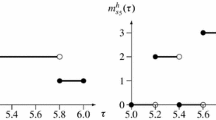Abstract
We address the stability properties of a benchmark general equilibrium model involving pervasive stickiness on information updating. Dynamic behavior is determined essentially by two types of entities: on one hand, the degree of information stickiness that characterizes the price-setting decisions of firms and the consumption and labor supply decisions of households and, on the other hand, a policy parameter that indicates how the central bank acts in order to stabilize prices. Under perfect foresight, stability will hold and the degree of information stickiness simply indicates the velocity of convergence towards the steady-state. If the ability to forecast future events is less than perfect, stability will then depend on monetary policy—the main result is that the stickier the diffusion of information is, the more aggressive monetary policy must be in order to guarantee convergence towards the long-term steady-state.
Similar content being viewed by others
References
Carrillo, J. A. (2010). How well does sticky information explain inflation and output inertia? METEOR Research Memoranda number 018.
Carroll C. D. (2003) Macroeconomic expectations of households and professional forecasters. Quarterly Journal of Economics 118: 269–298
Christiano L. J., Eichenbaum M., Evans C. L. (2005) Nominal rigidities and the dynamic effect of a shock to monetary policy. Journal of Political Economy 113: 1–45
Coibion O. (2010) Testing the sticky information Phillips curve. The Review of Economics and Statistics 92: 87–101
Coibion, O., & Gorodnichenko, Y. (2008). Strategic interaction among heterogeneous price-setters in an estimated DSGE model. NBER working paper no 14323.
Dopke J., Dovern J., Fritsche U., Slacalek J. (2008) Sticky information Phillips curves: European evidence. Journal of Money, Credit and Banking 40: 1513–1520
Gomes O. (2010) The sticky-information macro model: Beyond perfect foresight. Studies in Nonlinear Dynamics and Econometrics 14(1, article 1): 1–35
Khan H., Zhu Z. (2006) Estimates of the sticky-information Phillips curve for the United States. Journal of Money, Credit and Banking 38: 195–208
Kiley M. T. (2007) A quantitative comparison of sticky-price and sticky-information models of price setting. Journal of Money, Credit and Banking 39: 101–125
Korenok O. (2008) Empirical comparison of sticky price and sticky information models. Journal of Macroeconomics 30: 906–927
Korenok O., Swanson N. R. (2007) How sticky is sticky enough? A distributional and impulse response analysis of New Keynesian DSGE models. Journal of Money, Credit and Banking 39: 1481–1508
Luo Y. (2008) Consumption dynamics under information processing constraints. Review of Economic Dynamics 11: 366–385
Mackowiak B., Wiederholt M. (2009) Optimal sticky prices under rational inattention. American Economic Review 99: 769–803
Mankiw N. G., Reis R. (2002) Sticky information versus sticky prices: A proposal to replace the New Keynesian Phillips curve. Quarterly Journal of Economics 117: 1295–1328
Mankiw N. G., Reis R. (2003) Sticky information: A model of monetary nonneutrality and structural slumps. In: Aghion P., Frydman R., Stiglitz J. E., Woodford M. (eds) Knowledge, information and expectations in modern macroeconomics: In honor of Edmund S. Phelps. Princeton University Press, Princeton, pp 64–86
Mankiw N. G., Reis R. (2006) Pervasive stickiness. American Economic Review 96: 164–169
Mankiw N. G., Reis R. (2007) Sticky information in general equilibrium. Journal of the European Economic Association 5: 603–613
Molinari, B. (2010). Sticky information and inflation persistence: Evidence from U.S. data. Universidad Pablo de Olavide working paper no 10.09.
Morris S., Shin H. (2002) Unique equilibrium in a model of self-fulfilling currency attacks. American Economic Review 88: 587–597
Reis R. (2006a) Inattentive producers. Review of Economic Studies 73: 793–821
Reis R. (2006b) Inattentive consumers. Journal of Monetary Economics 53: 1761–1800
Reis, R. (2009). A sticky-information general-equilibrium model for policy analysis. NBER working paper no 14732.
Sims C. A. (1998) Stickiness. Carnegie-Rochester Conference Series on Public Policy 49: 317–356
Sims C. A. (2003) Implications of rational inattention. Journal of Monetary Economics 50: 665–690
Trabandt, M. (2007). Sticky information vs. sticky prices: A horse race in a DSGE framework. Kiel Institute for the World Economy working paper no 1369.
Author information
Authors and Affiliations
Corresponding author
Rights and permissions
About this article
Cite this article
Gomes, O. Transitional Dynamics in Sticky-Information General Equilibrium Models. Comput Econ 39, 387–407 (2012). https://doi.org/10.1007/s10614-010-9250-y
Accepted:
Published:
Issue Date:
DOI: https://doi.org/10.1007/s10614-010-9250-y




